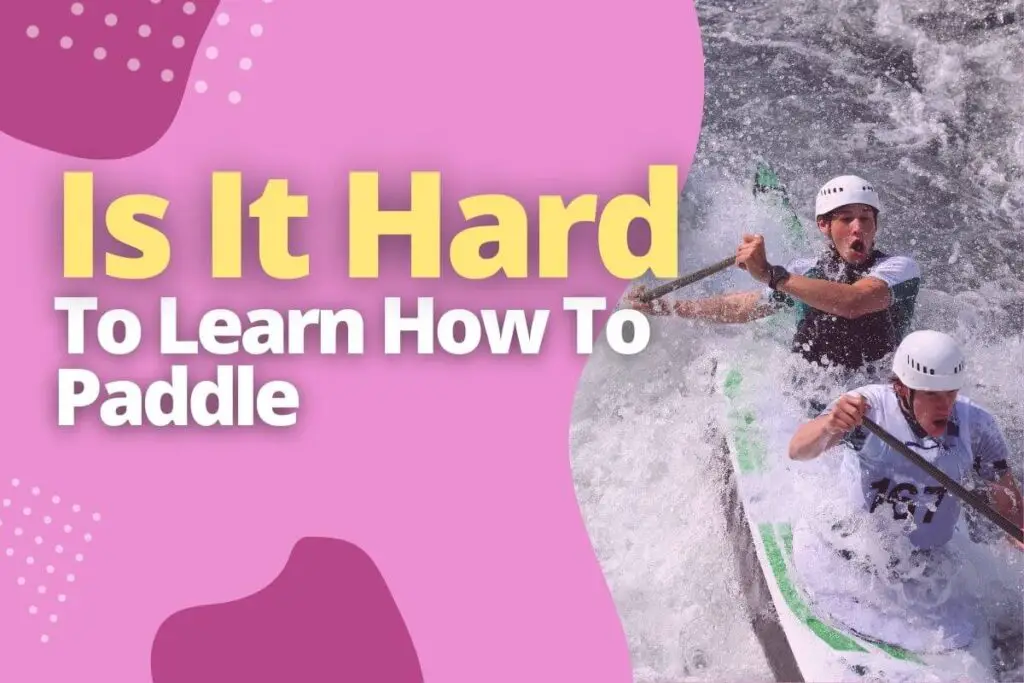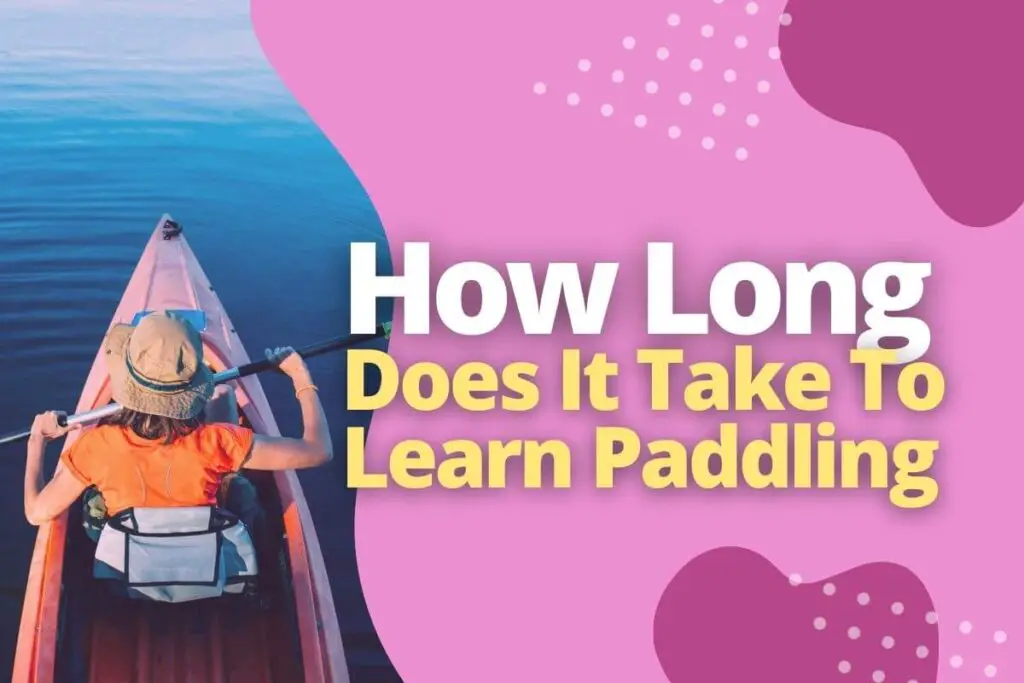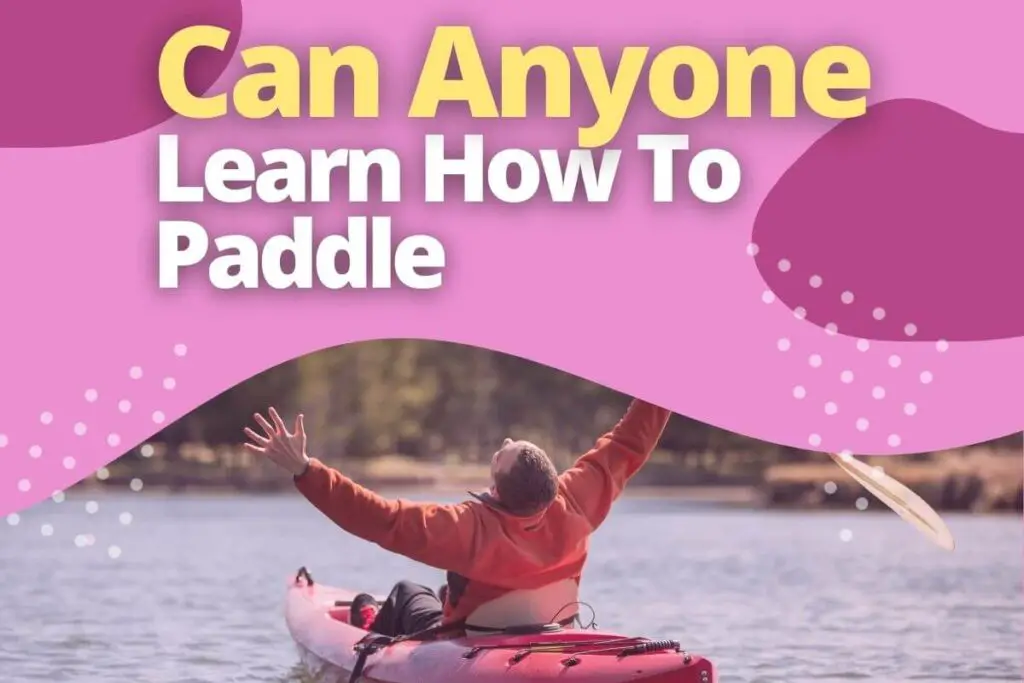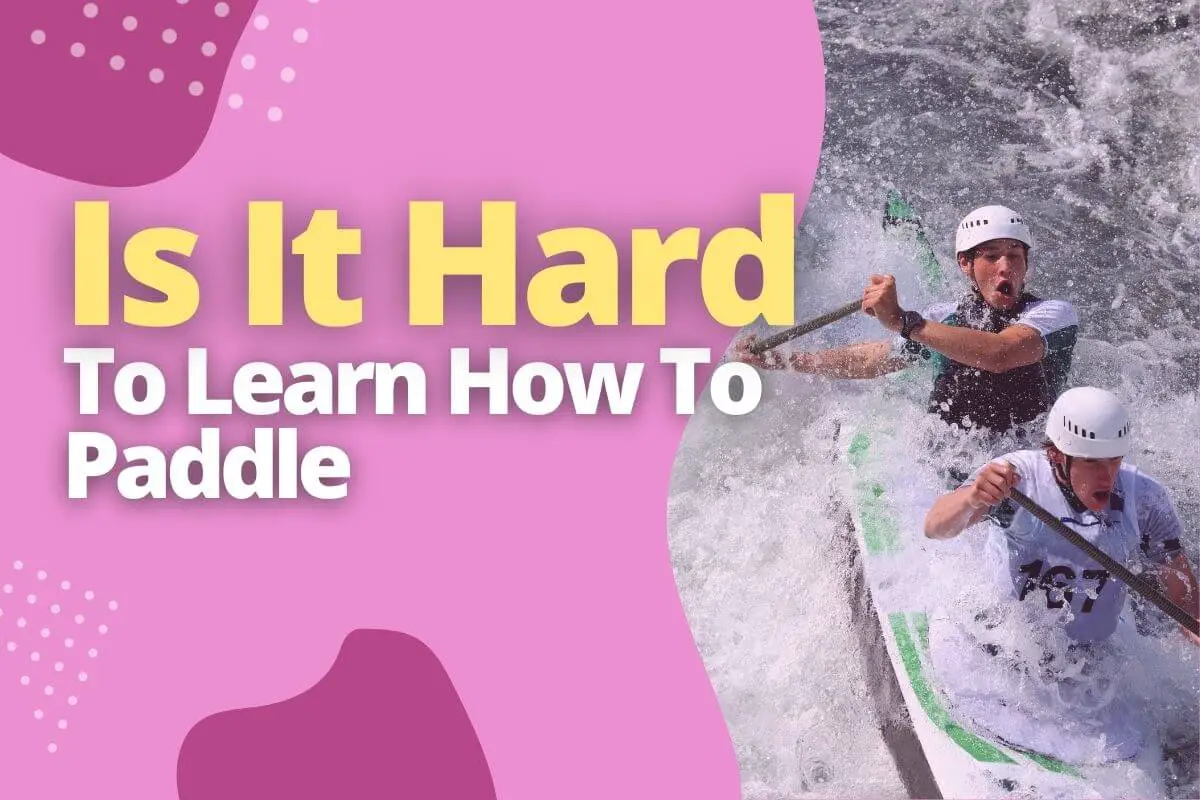Do you ever find yourself wishing that there was a way you could learn how to paddle a kayak, but you weren’t sure if it was hard to learn?
If you’re interested in learning how to paddle, you may be wondering if it’s hard to learn. And if so, what makes it difficult? In this article, we’ll dive into the specifics of learning how to paddle and whether or not it’s a good idea for beginners.
In this article, we’ll look at why it can be hard to learn and some tips for making the process easier.

Here’s The Answer To Is It Hard To Learn How To Paddle
In fact, learning how to paddle is not hard at all. It just takes time and practice. If you’re interested in this water sport but don’t know where to start, read on for some tips about learning how to paddle!
Undoubtedly, you’ll be able to learn this fun activity in no time. It takes time for your body to get used to the motions and for you to gain the strength and endurance needed.
It depends on so many things:
- The person
- The type of paddling you’re doing
- Your level of experience with that type of paddling (i.e., if you’re already an expert or beginner)
- The equipment you use (i.e., a kayak vs. a SUP vs. canoe)
- Where your journey takes place (i.e., calm river vs. choppy ocean waves)
Since these activities can be strenuous, it’s important to warm up and stretch before you paddle and cool down afterward. Once you learn the basics of how to paddle, you can enjoy it for a lifetime. In fact, paddling is good for your body and mind.
How Long Does It Take To Learn Paddling?

It depends on your skill level and experience. If you do have some experience, or if you’re younger, then learning may be easier for you.
- It also really depends on the person and how much time they are willing to put into it. Some people might be able to pick it up fairly quickly, while others might need a little more time to get the hang of it.
- Whether or not the person has any experience with kayaking or whitewater paddling. If someone is starting from scratch, it might take a little longer for them to get the hang of things. However, if someone has some experience with kayaking, they might be able to pick up paddling a little bit more quickly.
- Another thing is the type of kayak that the person is using. If someone is using a tandem kayak, they might need to spend a little bit more time getting used to paddling in unison with their partner. However, if someone is using a solo kayak, they might be able to pick up paddling a little bit more quickly.
The biggest challenge for most people when they are first learning to paddle is getting used to the upright position. When kayaking, most individuals are accustomed to sitting, so the upright position might be a bit of a challenge.
However, once you get the hang of it, it will be much easier to paddle.
How To Speedup Paddling Learning Process?
Learning how to paddle can be a daunting task. You will most likely make mistakes along the way, and you might even feel like giving up at some point.
However, there are ways in which you can speed up the learning process and help yourself learn how to paddle faster.
- Focus on learning the fundamentals of paddling before worrying about increasing your speed or becoming more efficient. This will give you a better understanding of what works best when it comes time for those types of improvements later on down the road.
- There are a few basic skills that all kayakers need to know in order to be able to paddle effectively. The first skill is how to grip the paddle correctly. The second skill is how to plant the blade of the paddle into the water. The third skill is how to pull the paddle through the water. The fourth skill is how to recover the paddle. The final skill is how to repeat the stroke.
- One of the best ways to learn how to paddle is to take kayaking lessons from a qualified instructor. However, if that is not an option, then it is possible to learn from an experienced paddler.
Can Learning From Someone With Experience Help Speedup The Learning Process?
If you want to learn as fast and efficiently as possible, having someone with experience can help you speed up the process and ensure that you don’t miss out on important information.
A friend may even be willing to take out a kayak with you so that they can teach you proper technique first-hand before going out on your own, which is probably safer than trying something new in open water.
- When someone is learning how to kayak for the first time, they may be able to learn the basics more quickly by learning from someone who has experience kayaking.
- For many people, learning from someone who has already gone through the process can be beneficial. One of the advantages of learning from someone with experience is that they can provide guidance and support.
- They can offer tips and tricks that can help you learn the ropes faster. They can also answer any questions you may have about the process.
Another advantage of learning from someone with experience is that they can help you avoid making mistakes. They can show you what to do and what not to do. This can save you time and frustration in the long run.
What Are The Benefits Of Learning How To Paddle?
Paddling is a great way to meet new people, travel in a new way, and see the world. It allows you to get away from your daily routine and relax while also getting exercise.
It is a great way to get some exercise. Paddling is also a great way to enjoy the outdoors and explore new places. In addition to the physical benefits, paddling can also be a great way to improve your mental health.
Paddling can help you to clear your mind and relax. It can also be a great way to spend time with friends and family. Paddling can also be a great way to learn new skills.
If you are a beginner, there are many paddling techniques that you can learn. If you are more experienced, you can learn how to canoe or kayak.
There are also many safety skills that you can learn when paddling. If you are paddling in a group, it is important to know how to signal for help if someone gets into trouble. You should also know how to properly wear a personal flotation device (PFD).
Can Anyone Learn How To Paddle?

The answer is yes. Anybody who can swim and is comfortable in the water can learn how to paddle. If you are physically able and have a good balance, then it’s possible for you as well!
With a little instruction and practice, almost anyone can learn how to paddle a kayak or canoe. Paddling is a fun and healthy way to spend time outside.
It’s also a great way to spend time with family and friends. Paddling can be done on many different bodies of water, from lazy rivers to the open ocean. Things to remember when you’re getting started.
- First, find a canoe or kayak that fits your body size and weight.
- Second, practice in calm, shallow water before venturing out into deeper water.
- And third, take some simple steps to improve your paddling technique.
With a little practice, you’ll be a better paddler in no time. You’ll also build stamina and burn calories, making paddling a great workout. So get out there and enjoy the water!
Do Kids Learn How To Paddle Faster Than Adults?
The answer is yes. Kids learn faster than adults because they have a lot of energy, are more flexible, more resilient, and focused on what they are doing.
They also try new things easily and don’t mind the risk involved with taking chances that adults might not be willing to take.
The answer to the question can also be complicated and depends on a number of factors, including the center of gravity of the kayak, the recreational kayak vs. canoeing partner, accessories, and the right kayak for the front seat.
Is It Safe To Learn How To Paddle By Yourself?
As you explore the world of paddling, it’s important to know about safety. Paddling is an accessible activity for people of all ages and abilities.
However, there are some things to keep in mind when you decide to start learning how to paddle by yourself or with a friend or two. Everything from the weather and water conditions to your own skill level can impact your experience on the water.
So before going out on open water alone, make sure you have a solid knowledge base of what makes paddling safe.
What Are Some Tips To Improve Paddling Technique?

In order to improve your paddling technique, it is important to realize that practice makes perfect. The more you practice paddling, the better you will become at it.
So if you want to improve your paddling technique, then make sure that you are practicing with a lot of consistency.
The following tips will help improve your paddling technique:
- Focus on the basics – Keep your head up and back straight as much as possible while also making sure that both elbows are out from the body (about 30 degrees). Also, keep both hands in the correct position for each stroke and try not to let either arm cross over the midline.
- Make sure you’re using the right paddle for your height and weight.
- Keep your paddle close to the kayak, and make sure your hands are close together.
- When you stroke, keep your elbows close to your body and your hands close to the paddle blade.
- Use your whole body to paddle, not just your arms.
- Practice paddling in different conditions, such as in windy or choppy water.
- Make sure you take breaks often, so you don’t get too tired.
What Are The Most Important Aspects of Learning How To Paddle
- Focus on your technique. It’s easy to get frustrated when you’re learning how to paddle, but don’t let that stop you from continuing your practice. Instead of focusing on the frustration, try thinking about how great it will feel once you’ve mastered the skill.
- Learn how to paddle in a straight line. You’ll find this useful in several different situations—for example, when a wind is coming from one direction, and there are obstructions like trees or rocks on either side of you—so it’s important that you master this skill early on.
- Learn how to paddle in circles around yourself or another person (or both). This is a great way for two people who are new at paddling together! Just make sure that whoever is “in charge” knows how much space they need so as not to hit anything else while doing their circle–then go ahead and have fun playing with each other!
Take Lessons if You’re New to It
If you’re new to paddling, it’s best to take lessons from a certified instructor. This will ensure that you learn the right way and don’t injure yourself.
As with any sport, having an experienced instructor is also helpful because he or she will know what common mistakes beginners make and how to avoid them.
If possible, find someone who is patient (you’ll probably be nervous and make mistakes) and good at communicating (you should understand what they’re saying).
Pay attention to whether the instructor is good at explaining things in terms of what’s going on with your body; this is essential for learning how to paddle correctly.
Make Use Of Online Resources

If you’re looking to learn how to paddleboard, the internet has a wealth of information at your fingertips. You can use the internet to find tutorials, tips and tricks, articles on what you need to buy in order to start paddling, and so much more.
If you have questions about how something works or what type of paddle board is best for your needs, there are tons of web pages out there that may help answer those questions for you.
Online resources will be useful during every step of this process: when figuring out whether it’s something that interests you enough; when purchasing equipment; when practicing at home; even when considering taking classes in person with an instructor (which I highly recommend).
Keep Safety First
- Keep safety first.
- Wear a life jacket whenever you’re in the water, even if you’ve never been swimming before.
- Be aware of your surroundings and know when to stop paddling if it becomes too dangerous.
- Never paddle alone or in rough waters, especially if there are no lifeguards around to help you out of the water.
- Avoid paddling near areas where there are no rescue boats or lifeguards on duty (like at night).
Get The Right Gear
If you’re looking for the correct gear, safety should always come first. The last thing you want is to go out on your kayak trip only to find out that your life jacket is not properly fitted, or worse, that it doesn’t fit at all.
If this happens while you’re in the middle of water and far away from land, then the chances are good that you will drown before help arrives.
If possible, try out different types of paddling shoes and gloves at local stores or online before buying them so that they feel comfortable on your feet and hands.
And aren’t too tight or loose in any areas where they need to be snugly fitted against the body for maximum comfortability during long trips (or even short ones).
Practice And Practice Again!
- Practice. Practice. Practice. It is the key to learning how to paddle.
- Practice with others when you can. It will help you learn faster and give you some friendly competition!
- You should practice in a safe environment where there are no obstacles or distractions like power boats or big waves that could make it difficult for someone who has never been on a SUP before (like yourself).
Conclusion
In this blog post, we discussed some of the most important aspects of learning how to paddle. It was also mentioned that learning how to paddle is not always easy.
It can be frustrating for people who are learning how to do it. This is why it’s important to keep your chin up and learn how to do it.
We hope that we have provided enough information to help you decide if you want to learn how to paddle or not. If yes, then use the above tips and guide in order to make it easy for yourself.
If you want to learn how to paddle, don’t let the initial learning curve keep you from enjoying your time on the water. If you get stuck, check out the tips mentioned in this post.
You may find that they help you get back on track and learn more effectively.

